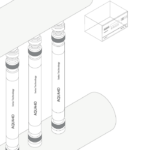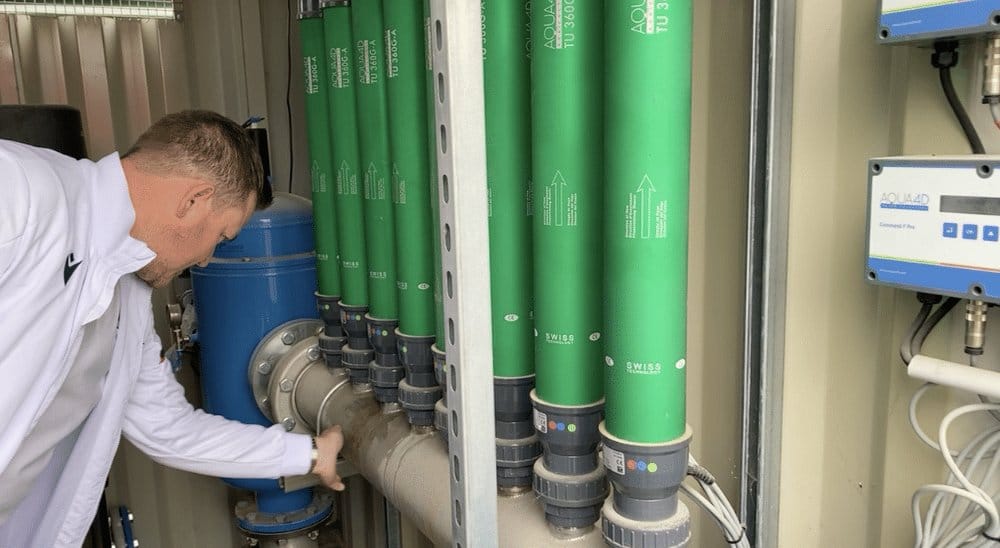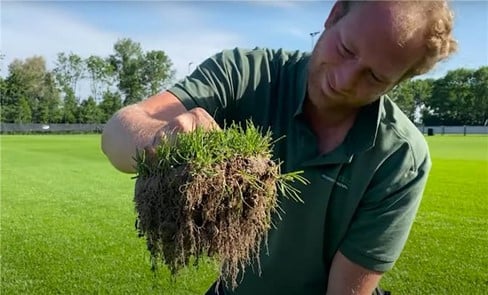This article was published in French in Gazon Sport Pro 24 – read the original here.
Serving the sports irrigation market since 2020, the company AQUA4D® aims to optimize irrigation thanks to a system that directly impacts water and its behavior. Gazon Sport Pro H24 explores this innovative system, already used by many in France and abroad.
The mission of Switzerland’s AQUA4D? To make irrigation and water processes more efficient by modifying the physical structure of water. They’ve been active in sports irrigation since 2020, but were in fact founded back in 2004. Starting with the aim of solving mineral and organic clogging issues in pipes, their R&D department soon found that the technology could also lead to significant irrigation efficiencies by improving infiltration and mineral diffusion in the soil.
They are now well-established in the agricultural sector, which represents more than 75% of its clientele (along with green spaces and sports fields), and more than 5000 installations worldwide. The company has now expanded the proven efficiencies in agriculture to the sports and landscapes market, with some notable early successes in soccer, where European clubs such as OGC Nice and AZ Alkmaar use its system.
Installation at OGC Nice, France
AQUA4D® technology explained
The system consists of two units: the Control Unit that generates the low frequency signals and controls the proper functioning of the system; and the Treatment Units that diffuse the generated resonance fields into the water.
The system is installed after the pumping, filtration and fertilization station if applicable. Each Treatment Unit has a capacity of 22m3/h, each control box can drive 4 Treatment Units. “Depending on the flow rate to be treated, we can put as many Treatment Units and controls as necessary in parallel. For example, for a flow rate of 160m3/h, we will install an FA-Pro 80M composed of 8 Treatment Units and 2 Control Units”, explains Thierry Koch, International Sales Manager for the Swiss company.
Thanks to the diffusion of these resonance fields, the system acts directly on the physical structure of the water and will modify the interactions between the liquid and solid interfaces. This will allow a better penetration of water in the soil, a better infiltration in the soil micropores, and greater retention leading to water savings. It also allows a better hydration, dissolution, and assimilation of mineral elements and fertilizers.

Scientifically proven effects on water and plants
The physical treatment of water by AQUA4D® has been the subject of numerous scientific studies with universities and agronomic research centers across the world. The studies have shown that the treatment not only acts on the structure of the water but can also influence several soil properties (salinity, microporosity, macroporosity).
The water is not chemically modified and all the mineral elements that compose it remain intact after the diffusion of the waves. The system acts in particular on the grouping of water clusters, which are “broken up” by resonance.
The size of these water clusters (set of water molecules linked by hydrogen bonds) is reduced; the distribution is finer and regular, and the water becomes more “fluid”. The shape of the mineral elements present in the water is also modified. This has important consequences: a better solubility of minerals and a better assimilation by plants. And, importantly for water efficiency, this water now penetrates better into the micropores of the soil.
Flattening of the water drop after physical treatment
The system also has an effect on the development of the plant, leading to a better development of the root system. “There are several explanations, the first is related to the cleaning of irrigation networks and the cleaning of biofilms present in them. Indeed, we know that biofilms, which are composed of algae and organic matter, consume part of the oxygen present in the water,” explains Thierry Koch. “The fact of increasing or maintaining a high level of oxygen in the water allows a better development of the roots. Also, since water penetrates into the soil micropores, roots can fetch water from these micropores by developing fine ‘hairy’ roots. And finally, a better availability of the water and the mineral elements also take part in this better root development.”
With denser roots and a better infiltration in the soil, water loss is limited and the savings are important (25% of water saving on average). Generally speaking, the plant is less subject to water stress, and its health and vegetative development are enhanced.
Root development of the AZ Alkmaar pitch after using the AQUA4D® system
This water treatment had a clear impact on the grass at AZ Alkmaar – after just 6 weeks, the grass was greener and the root systems more robust and abundant.
“The result is magnificent, we have plenty of hairy roots now,” comments Head Groundsman, Wouter Uitentuis. “The nutrients are absorbed because the root zone is good, and the fertilizer is better absorbed which is why the grass stays as green as it is.”
With water management for sports field maintenance more than ever in the spotlight, this physical treatment of water by resonance fields could be a solution to be explored to achieve more efficient precision irrigation.
—–
Full interview with AZ Alkmaar’s Head Groundsman:
Original author: Richard Corentin
Sports & Landscapes
Precision Irrigation
Turf Management
“The result is magnificent, we have plenty of hairy roots now. The nutrients are absorbed because the root zone is good, and the fertilizer is better absorbed which is why the grass stays as green as it is.” – Wouter Uitentuis, Groundsman, AZ Alkmaar
OGC Nice’s Scott Brooks explains the AQUA4D® effect on his turf





